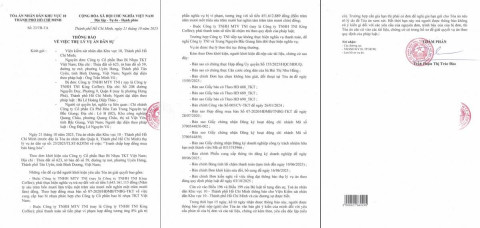Interest rate cut and the impact on Vietnam's economy
- 165
- Business
- 15:53 19/06/2024
DNHN - According to Dr. Chu Thanh Tuan, Deputy Head of the Bachelor of Business program at RMIT University, the recent interest rate cuts by major central banks may impact Vietnam's export market.

General situation and assessment of ECB, BOC interest rate cuts
The recent interest rate cuts by the European Central Bank (ECB) and the Bank of Canada (BoC) are significant moves indicating a broader trend of monetary easing among major central banks. Here is an analysis of how these cuts could affect the global economy:
On June 6, 2024, the ECB reduced its deposit rate from 4.0% to 3.75%, the first cut since 2019. This decision was influenced by a drop in inflation, which has fallen from over 10% at the end of 2022 to near the ECB's target of 2%.
However, the ECB remains cautious, indicating that further rate cuts will depend on upcoming economic data. They have raised inflation forecasts, suggesting inflation might still exceed the target next year. This cautious stance implies that while the rate cut provides immediate economic relief, the ECB is ready to tighten policy again if inflation proves persistent.
On June 5, 2024, the BoC cut its benchmark rate by 25 basis points to 4.75%, marking the end of a series of rate hikes aimed at combating inflation. This move reflects progress in controlling inflation and supporting economic growth. However, the BoC's decision contrasts with the U.S. Federal Reserve, which has kept rates steady due to higher-than-expected inflation. The BoC's rate cut is expected to lower borrowing costs for consumers and businesses, potentially stimulating economic activity and easing financial conditions.
Current trends of other Central banks worldwide
The U.S. Federal Reserve (Fed) has paused rate hikes despite previous plans for further increases, reflecting a cautious approach amid mixed economic signals, particularly persistent inflation pressures. Future rate decisions will likely depend on upcoming job and inflation data.
The Bank of England (BoE) has also maintained a high rate, currently at 5.25%, due to ongoing inflation concerns, especially in the services sector. Like the Fed, the BoE is taking a wait-and-see approach regarding future rate cuts.
In March 2024, the Bank of Japan (BoJ) made a significant shift by abandoning its negative interest rate policy for the first time in decades, raising short-term rates to around 0-0.1% from negative 0.1%. This move ends Japan's unprecedented monetary easing era. The BoJ has discussed the possibility of further rate hikes if a weak yen continues to push inflation higher, as indicated in recent meeting minutes.
The Reserve Bank of Australia (RBA) has recently paused rate hikes, focusing on assessing the impact of previous increases on the economy. However, the RBA has indicated it may resume rate hikes if inflationary pressures persist.
The People's Bank of China (PBC) has been more aggressive with easing measures, cutting key interest rate to support economic recovery amid slowing growth and deflation risks. This is part of a broader strategy to stabilize the economy and support domestic demand.
Impact of ECB and BOC rate cuts on the global economy
The ECB and BoC rate cuts could impact the global economy as follows:
- Economic Growth: Divergent monetary policies among major central banks may lead to varying economic outcomes. Countries with easing policies, like Canada and the Eurozone, may see increased consumer spending and investment, potentially boosting economic growth. In contrast, regions maintaining higher rates may experience slower growth due to high borrowing costs.
- Global Trade: Interest rate differentials can affect currency values, impacting global trade dynamics. For example, a weaker euro or Canadian dollar could make exports from these regions more competitive, potentially improving trade balances. However, it could also increase import costs, contributing to inflationary pressures.
- Financial Markets: Lower interest rates generally support higher stock prices by reducing borrowing costs for businesses and increasing consumer spending. However, this trend can also cause volatility as markets react to monetary policy changes and economic data. Bond markets, in particular, may see fluctuating yields as investors adjust their expectations based on central bank actions.
- Inflation Management: Central bank rate cuts aim to support economic activity but must balance this with the risk of reigniting inflation. This is particularly challenging given persistent inflationary pressures in many economies. Successfully managing this balance is crucial for long-term economic stability.
- Global Economic Coordination: The differing approaches of central banks reflect the varied economic conditions and challenges faced by each region. While some economies are easing to stimulate growth, others remain cautious to avoid a resurgence of inflation. This lack of coordination can complicate global economic interactions, including trade and investment flows.
Opportunities and challenges for Vietnam and policy recommendations
Vietnam, with its export-oriented economy, is highly susceptible to global economic fluctuations. The recent interest rate cuts by major central banks like the ECB and BoC could lead to currency volatility and changes in global trade dynamics, affecting Vietnam's export markets.
The ECB and BoC rate cuts might lead to the depreciation of the euro and Canadian dollar, making European and Canadian goods cheaper in global markets. This could potentially affect Vietnam's exports, making them relatively more expensive. However, reduced borrowing costs in Europe and Canada might boost economic activity in these regions, possibly increasing demand for Vietnamese exports. This could benefit sectors like textiles, electronics, and agriculture, which are significant contributors to Vietnam's exports.
Vietnam's rapid economic growth is significantly driven by foreign direct investment (FDI). Global interest rate changes can influence FDI flows, with investors potentially seeking higher returns in other markets. Lower interest rates in Europe and Canada might encourage investors to seek higher returns in emerging markets like Vietnam, potentially increasing FDI, particularly in manufacturing and technology sectors.
Vietnam could become more attractive to European and Canadian companies looking to relocate or expand due to lower operational costs and favorable investment conditions. As borrowing costs decrease, consumer spending in Europe and Canada might rise, leading to higher discretionary spending on travel. This could benefit Vietnam's tourism industry, which is recovering from the pandemic.
A weaker euro and Canadian dollar could lead to cheaper imports from these regions, potentially lowering input costs for Vietnamese businesses. However, it could also increase competition for local manufacturers.

Recommendations for Vietnam:
First, enhance trade policy through market diversification. Reduce dependence on any single market by expanding trade relations with other countries. This can help mitigate risks associated with currency fluctuations and economic downturns in specific regions. Improve export competitiveness by focusing on enhancing the quality and added value of Vietnamese exports to maintain competitiveness despite currency changes.
Second, boost economic resilience through domestic consumption. Develop policies to encourage domestic consumption to minimize the economy's vulnerability to external shocks. This includes supporting small and medium-sized enterprises and investing in consumer-oriented sectors. Focus on improving infrastructure to support efficient supply chains and logistics, making Vietnam an attractive destination for FDI and trade.
Third, attract foreign investment through a stable investment environment. Maintain a stable and predictable regulatory environment to attract and retain foreign investors. This includes transparent legal processes, property rights protection, and incentives for high-tech industries. Offer incentives for investments in high-tech and high-value sectors to diversify the economic base and reduce reliance on traditional manufacturing.
Fourth, in light of the ECB and BoC rate cuts, the government should implement a flexible exchange rate policy to respond to external shocks and maintain economic stability. This involves actively monitoring global financial markets and appropriate interventions when necessary. Build robust foreign exchange reserves to buffer against currency volatility and external economic pressures.
The recent rate cuts by the ECB and BoC are part of a broader trend among central banks reacting to specific domestic economic conditions. The impacts on the global economy include changes in growth trajectories, trade balances, financial market dynamics, and inflation management. As central banks navigate these complex conditions, their policies will continue to shape the global economic landscape.
Vietnam faces both opportunities and challenges. By diversifying trade markets, enhancing economic resilience, attracting foreign investment, managing currency risks, and boosting tourism, Vietnam can effectively navigate the impacts of global monetary policy changes and sustain economic growth.
Dr. Chu Thanh Tuan (Deputy Head of the Bachelor of Business program, RMIT University)
Related news
#Vietnam’s economy

What are the main challenges facing Vietnam's economy on the path to sustainable development?
Vietnam is facing significant challenges in economic development due to its reliance on resources and cheap labor.

Economic expert Võ Trí Thành assessed: President Donald Trump’s new trade policy will impact Vietnam
According to Dr. Võ Trí Thành, Director of the Institute for Brand and Competitive Strategy Research, Donald Trump’s new trade policy will have significant effects on Vietnam’s economy. He also provides strategic recommendations for businesses.

EuroCham: European enterprises confident in Vietnam's long-term economic growth
Nearly 70% of businesses express confidence in Vietnam's economic growth over the next five years, with many companies ready to recommend Vietnam as an investment destination.

G&P Global Ratings raises Vietnam’s sovereign credit rating
The S&P Global Ratings on May 26 raised its long-term sovereign credit rating on Vietnam to “BB ” with a “stable” outlook on the back of strong economic recovery, according to the Ministry of Finance.

What do domestic businesses need to overcome difficulties?
Strong and synchronized government support policies are crucial in helping Vietnamese enterprises navigate the current challenging period.

State budget revenue shows promising growth amidst global economic challenges
Amidst a complex global economic backdrop, the review report on the 2024 state budget reveals encouraging results.
Đọc thêm Business
From New Year messages of World Leaders to the “new rules” of the Global economy in 2026
At a pivotal moment of transition, New Year messages from capitals such as Hanoi, Beijing, Washington and Paris reflect distinct priorities and strategic visions.
Connecting Leaders, Shaping the Future: Strategic Leadership Planning Meeting – CorporateConnections Hanoi A
"Your network is your most powerful flowing asset. It generates value, multiplies opportunities, and accelerates your influence across borders."
Innovative ESG enterprise: Trạm Xe Việt startup proposes solutions to build a green mobility ecosystem
As Vietnam commits to achieving Net Zero by 2050 and tightens emissions standards, the transportation sector faces unprecedented pressure to transform.
Deputy Prime Minister Nguyễn Chí Dũng: “The country’s major challenges weigh heavily on my mind — and we must resolve them together.
On the morning of November 26, 2025, Deputy Prime Minister Nguyễn Chí Dũng chaired a high-level working session at the National Innovation Center (NIC) in Hòa Lạc.
Unitsky String Technologies signs cooperation agreements with three Vietnamese partners, opening a new direction for smart mobility and sustainable development
The signing ceremony took place in Minsk, Belarus, on November 28, 2025.
Before the D‑day to abolish flat‑rate tax: Fear of technology and costs leave small traders struggling to adapt
From 1 January 2026 the flat‑rate tax regime will be abolished. Small business households will be required to declare tax based on actual revenue. MISA supports the transition with technology to help micro‑merchants adapt smoothly and transparently.
Vietnamese enterprises at a crossroads: the impact of a potential US–China deal
As the world closely monitors every shift in US-China relations, emerging signals of a strategic agreement between the two global powers are raising hopes for global economic stability.
HDBank: Impressive profit growth, leading in profitability and advancing international integration
Ho Chi Minh City Development Joint Stock Commercial Bank (HDBank, stock code HDB) announced its consolidated profit before tax for the first 9 months of 2025 reached VND 14,803 billion, marking a 17% increase year-on-year (YoY).
TNI King Coffee sued for over VND 5 Billion in unpaid debts
On October 21, 2025, the People’s Court of District 10 in Ho Chi Minh City officially accepted a civil lawsuit concerning a commercial contract dispute between TKT Vietnam Plastic Packaging Joint Stock Company and TNI King Coffee Co., Ltd.
VINASME and Jeonnam Technopark Sign MOU on technology cooperation, human resource training, and trade promotion
On October 15, 2025, in Hanoi, VINASME and Jeonnam Technopark (Korea) signed an MOU to promote trade, advance technology transfer, and develop human resources between enterprises of both nations.











